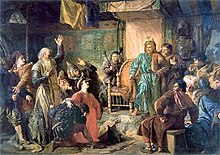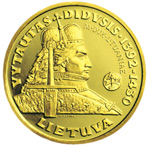Vytautas
| Vytautas the Great | |
|---|---|
| Grand Duke of Lithuania Duke of Trakai Postulated King of Hussites |
|

17th century painting
|
|
| Reign | August 4, 1392 – October 27, 1430 |
| Predecessor | Skirgaila |
| Successor | Švitrigaila |
| Born | ~1350 Senieji Trakai |
| Died | October 27, 1430 Trakai |
| Burial | Vilnius Cathedral, Vilnius |
| House | House of Kęstutis |
| Dynasty | Gediminids |
| Father | Kęstutis |
| Mother | Birutė |
In modern Lithuania, Vytautas is revered as a national hero and was an important figure in the national rebirth in the 19th century. Vytautas is a popular male given name in Lithuania. In commemoration of the 500-year anniversary of his death, Vytautas Magnus University was named after him. Monuments in his honour were built in many towns in the independent Republic of Lithuania during the interwar period, from 1918–1939.
Contents
Struggle for power
1377–1384
Vytautas' uncle Algirdas had been Grand Duke of Lithuania until his death in 1377. Algirdas and Vytautas' father Kęstutis had practically ruled jointly, with Algirdas governing the east and Kęstutis the west, primarily responsible for defense against the Teutonic Order. Algirdas was succeeded by his son Jogaila, and a struggle for power ensued. In 1380, Jogaila signed the secret Treaty of Dovydiškės with the Teutonic Order against Kęstutis. When Kęstutis discovered this in 1381, he seized Vilnius, imprisoned Jogaila, and made himself Grand Duke. However, Jogaila escaped and raised an army against Kęstutis. The two sides confronted each other but never engaged in battle. Kęstutis was ready to negotiate, but he and Vytautas were arrested and transported to Kreva Castle. One week later, Kęstutis was found dead. Whether he died of natural causes or was murdered is still a matter of debate.
Vytautas and Kęstutis imprisoned by Jogaila. Painting by Wojciech Gerson
1385–1392
Poland and Lithuania, 1386–1434
Jogaila left his brother Skirgaila as regent in Lithuania. However, Skirgaila was unpopular with the people and Vytautas saw an opportunity to become Grand Duke. In 1389, he attacked Vilnius but failed. In early 1390, Vytautas again allied with the Teutonic Order. Vytautas had to confirm his agreement of 1384, and cede Samogitia to the Order. His army now invaded Lithuania. Also, to gain more influence, Vytautas married his only daughter Sophia to Vasili I of Russia in 1391.
The Polish nobles were unhappy that their new king spent too much time on Lithuanian affairs. It was clear that the war could continue for years and would not bring any benefit to Poland. In 1392, Władysław sent Henry of Masovia with an offer to make Vytautas regent instead of Skirgaila. Vytautas accepted and again broke with the Order. He burned three Teutonic castles and returned to Vilnius. Jagiełło and Vytautas signed the Astrava Treaty in which Vytautas recovered all Kęstutis' lands, including Trakai, and was given more. Vytautas would rule Lithuania in the name of Władysław. After Vytautas' death, all his lands and powers would revert to Władysław.
Grand Duke of Lithuania
Policy towards the East
Privilege to Vilnius Cathedral issued by Vytautas in Vilnius on February 16, 1410
Inspired by this successful campaign, Vytautas and Wladyslaw II Jagiełło won support from Pope Boniface IX for organising a crusade against the Mongols. This political move also demonstrated that Lithuania had fully accepted Christianity and was defending the faith on its own, and that the Teutonic Knights had no further basis for attacks against Lithuania. The campaign resulted in a crushing defeat at the Battle of the Vorskla River in 1399. Over twenty princes, including two brothers of Władysław II Jagiełło, were killed, and Vytautas himself barely escaped alive. This came as a shock to the Grand Duchy of Lithuania and Poland. A number of territories revolted against Vytautas, and Smolensk was retaken by its hereditary ruler, George of Smolensk and not re-conquered by Lithuanians until 1404. Vytautas waged a war in 1406–1408 against his son-in-law Vasili I of Moscow and Švitrigaila, a brother of Jogaila who with the support of the Teutonic Order had declared himself grand prince. A major stand-off between the two armies ended without a battle in the Treaty of Ugra, by which Velikiy Novgorod was granted to Jogaila's brother Simeon Lingwen, and the important city of Pskov to Jogaila's envoy Jerzy Nos, the latter settlement a clear violation of the treaty of Raciąż.[2][3] The war with Muscovy ended in December 1408, on terms that made further conflict with the Teutonic Order inevitable, despite Hermann II of Celje's attempt to negotiate a solution.[4]
Wars against the Teutonic Order
Vytautas the Great as shown on Jan Matejko's oil painting of the Battle of Grunwald
Vytautas the Great Monument in Kaunas
In 1408, Vytautas reached peace in the east and returned to Samogitian matters. In 1409 the second Samogitian uprising against the Teutonic Knights began, as the rebels burned Skirsnemunė castle. Both Poland and Lithuania supported the rebels. Vytautas gathered a large army from 18 lands under his control. The army joined Polish forces and advanced towards the Teutonic headquarters at the castle of Marienburg (present-day Malbork). In 1410, Vytautas himself commanded the forces of the Grand Duchy in the Battle of Grunwald, also called the Battle of Žalgiris (Lithuanian) or Tannenberg (German). The battle ended in a decisive Polish-Lithuanian victory. Even though the siege of Marienburg was unsuccessful, the Teutonic Knights never regained their strength and from then on posed a reduced threat to Poland-Lithuania.
As a result of the Peace of Thorn of 1411, Vytautas received Žemaitija (Samogitia) for his lifetime. However, the parties could not agree on the border. Sigismund, Holy Roman Emperor, agreed to mediate the dispute. In 1413, it was declared that the whole right bank of the Nemunas (Neman River) was Žemaitija and therefore belonged to Lithuania. The Teutonic Knights disagreed and a new war started in 1414. The war lasted for just a few months, and the dispute was brought to the Council of Constance. Even though the dispute was not resolved, the Samogitians had a chance to present their case to the leaders of Europe. It is seen as an important event in the diplomatic history of Lithuania. Several other mediation attempts failed, and yet another war with the Teutonic Order started in 1422. After several months of fighting, the Treaty of Lake Melno was signed. Žemaitija/Samogitia was returned to Lithuania in perpetuity, while the city of Memel (present-day Klaipėda) and surrounding territories stayed with the Order. This border, as established by the treaty, remained stable for some 500 years until the Memel Territory dispute of 1923. With peace established, Vytautas could now concentrate on reforms and the relationship with Poland.
Relationship with Poland
In 1399 Jadwiga of Poland and her newborn died in childbirth. Jogaila's power in Poland was jeopardised as he was a foreigner king with no other ties to the throne but his wife. Also, the defeat at Vorskla forced a re-evaluation of the relationship between Poland and Lithuania. The result was the Union of Vilnius and Radom in 1401. Vytautas was granted wide autonomy, but after his death the title and powers of Grand Duke of Lithuania were to be transferred to the king of Poland or vice versa. In case Jagiełło died first without an heir, the Polish nobility agreed not to elect a new king without consulting Vytautas. The unique feature of this union was that the Lithuanian nobility presented their own document: for the first time somebody other than dukes played a role in the state matters.
Church of Vytautas the Great. Built around 1400 in Kaunas
In January 1429, at the Congress of Lutsk Vytautas received the title of King of Lithuania with the backing of Sigismund, Holy Roman Emperor, but the envoys who were transporting the crown were stopped by Polish magnates in autumn of 1430. Another crown was sent, but Vytautas died in the Trakai Island Castle several days before it reached Lithuania. He was buried in the Cathedral of Vilnius. The knowledge about his remains has been lost.
According to 1911 Encyclopædia Britannica, Vytautas "was certainly the most imposing personality of his day in Eastern Europe, and his martial valour was combined with statesmanlike foresight."
Reforms
Litas commemorative coin dedicated to Vytautas the Great
In 1398, Vytautas brought over families of the Karaim (388 families) and Tatar peoples. Their principal role was to guard the castle and the bridges, but they also served as translators, farmers, traders, and diplomats. He retains a very high reputation among them, with the anniversary of his death being officially celebrated in 1930 in the kenesa in Vilnius.[5]
Family
According to the 16th century Bychowiec Chronicle, his first wife was Maria Łukomska, however, this is not confirmed by other sources.[8]
In fiction
Vytautas appears in several works of fiction dealing with the Polish-Lithuanian conflict with the Teutonic Order. He appears in the narrative poem Konrad Wallenrod by Adam Mickiewicz. He was portrayed by Józef Kostecki in Knights of the Teutonic Order, the 1960 adaptation of the famous novel by Henryk Sienkiewicz.In 2014, a short animation was produced by "Four Directions of Fairy Tales" (Cztery Strony Bajek) in association with the Association of Polish Karaims, portraying the Karaim story of Vytautas and his magic horse, with voiceovers in several languages, including Karaim, Polish, English, and Lithuanian.[9]
See also
| Wikimedia Commons has media related to Vytautas the Great. |
- Gediminids
- House of Kęstutis – family tree of Vytautas
- Order of Vytautas the Great
Notes
- English version on youtube: https://www.youtube.com/watch?v=PpGQ5USWVOA
References
| Wikisource has the text of the 1911 Encyclopædia Britannica article Witowt. |
- (in Lithuanian) Inga Deidulė, Vytauto Didžiojo įvaizdžio genezės mįslė, - "ieškokite moterų", Vartiklis. Accessed May 20, 2006.
- (in Lithuanian) Andrius Mingėla, Vytautas Lietuvos didysis kunigaikštis, Juventa high school. Accessed May 20, 2006.
- Oscar Halecki, Borderlands of Western Civilization: A History of East Central Europe, 2nd edition, Chapter 8, Simon Publications, July 2001, ISBN 0-9665734-8-X
- Vytautas and Karaims, Lithuanian Karaims Culture Community. Accessed May 20, 2006.
|
Vytautas
Born: c. 1296 Died: May 1377 |
||
| Preceded by Skirgaila |
Grand Prince of Lithuania as regent of Jogaila 1392–1430 |
Succeeded by Svitrigaila |
| Preceded by Skirgaila |
Duke of Trakai 1392–1413 |
Succeeded by Duchy transformed into voivodeship |
| Preceded by title created |
Grand Duke of Ruthenia 1398–1430 |
Succeeded by Svitrigaila |








Tidak ada komentar:
Posting Komentar